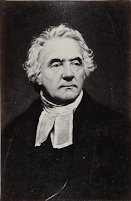Thomas Chalmers (1780-1847)
Thomas Chalmers (17 March 1780 – 31 May 1847), a Scottish pastor, political economist, and professor of theology served as a prominent figure in both the Church of Scotland and the Free Church of Scotland. He has been referred to as "Scotland's finest churchman of the nineteenth century." From 1835 until 1842, he held the position of Vice-President of the Royal Society of Edinburgh. After Chalmers, the town of Port Chalmers was established in New Zealand. In Stirling's Hall of Heroes of the National Wallace Monument, a bust of Chalmers is on exhibit. In Kirkliston, he is honored with the Thomas Chalmers Centre name.
Early Life
Born in Anstruther on Scotland's east coast, Thomas Chalmers received his training as a Presbyterian minister (Church of Scotland). He became a professor's assistant at St. Andrews (Scotland's first university), where he spent a significant amount of time studying mathematics. He received his ordination as a clergyman for the Kilmany parish in 1803. In 1815, after recovering from a serious illness, he relocated to Glasgow and took a position as minister of the Tron Church. In the UK, he gained a reputation as a preacher.
Due to his rural upbringing, he found the extreme poverty in industrial Glasgow to be extremely upsetting. He began experimenting with the parish's organizational structure, work that continued after he was appointed priest of the St. John church and parish in Glasgow in September 1819. Since he was adamantly opposed to public help, he actively discouraged the poor in his parish from depending on the official poor relief program run by the city council. In fact, he believed that receiving nearly any type of assistance served as a deterrent to seeking employment and making one's own way. Chalmers was confident that neighborhood cooperation and mutual support were far more effective than government-sponsored charity. These would just serve as a motivator for people to ask for more and more, which would diminish their sense of personal accountability and duty.
Chalmers believed direct connection to the community was required
Chalmers believed that what was required was a direct connection to the community that would address issues through neighborhood cooperation. The impoverished may work and be modest while increasing their personal responsibilities if they were included in the community. Every time money was required, it should come from the religious sector. It was necessary to favor charity since it inspires generosity in the giver.
Chalmers divided his parish into various areas (proportions) and assigned a deacon to each one as a result of his systematic thinking. Residents were expected to get very regular home visits. One of the deacons' responsibilities was to make friends with the impoverished and keep an eye on their circumstances, including their financial status, social networks, and familial and other relationships. The foundation for care and assistance would be this. Chalmers coordinated good elementary education at the same time as well as weekend schools where kids may acquire additional secular and religious education.
Thomas Chalmers put key ideas to help the poor
- He put one of his key ideas to help the needy help themselves into practice using these principles; this is strikingly similar to Octavia Hill's motto, "Help without alms." All of this was made possible by our cordial visits.
- Thomas Chalmers' strategy generated a lot of interest and had an impact on people like Charles Loch, who founded the English Charity Organization Society,
- Joseph Tuckermann, who founded the Boston Society for the Prevention of Pauperism in 1835, and Mary Richmond (who used it in her Friendly visiting among the poor, 1899).
- Examples of countries where Chalmers' ideas were exported include Germany and the Netherlands (the "liefdadigheid naar vermogen" in 1871).
The ideas of Chalmers still have use in modern social work. The current policy advances on the Big Society in Britain and community care are key examples of his methodology. His critique of welfare benefits is strikingly similar to Charles Murray's critique of social policy, which is considerably more contemporary.



Comments